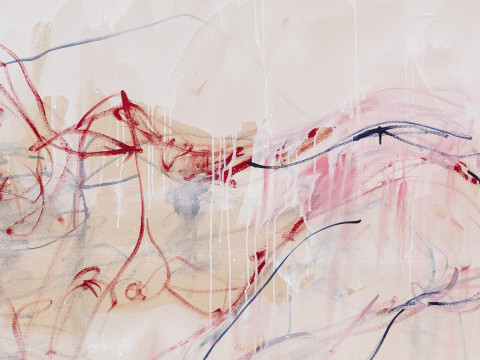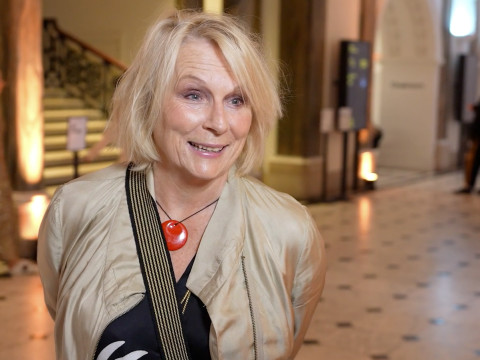
‘Deeds not words’: Suffragettes and the Summer Exhibition
By Helena Bonett
Published on 18 June 2018
The Great Spectacle charts 250 years of Summer Exhibitions – including 1914, when Suffragette Mary Wood attacked a John Singer Sargent portrait with a meat cleaver. We delve into the Royal Academy’s archive to find out how the Academy, and the public, reacted.
This article was originally published on the RA website in July 2013.
May 1914 was a busy month for the guards at the Royal Academy’s annual Summer Exhibition. On 4 May, the day the exhibition opened, the suffragette Mary Wood (an alias of Mary Aldham) attacked John Singer Sargent RA’s portrait of the author Henry James, breaking through the glass and slashing the canvas three times with a meat cleaver.
Prior to this moment, the Academy had not been subject to damaging suffragette action. In June 1909 a poster reading ‘Votes for Women’ had been stuck to the glass-framed front of Solomon J. Solomon RA’s portrait of the Prime Minister, Herbert Henry Asquith. Recorded in the RA’s Council minutes for 4 March 1912, the Academy had taken the decision to close the Winter Exhibition over a week early in order to ‘safeguard the valuable pictures now on loan’ following the damage of property elsewhere by suffragettes. The climate intensified over the coming year: a group of suffragettes broke the protective glass of a number of paintings at Manchester Art Gallery in April 1913, and on 12 June the RA’s Council minutes report that a group of suffragettes had attempted to hold a meeting in one of the galleries during that year’s Summer Exhibition; following this a number of cupboards, gates and doors at the RA were kept locked as a preventative measure.
But it was the famous attack by Mary Richardson on Velázquez’s Rokeby Venus at the National Gallery in March 1914 – in which she slashed the painting repeatedly with a meat cleaver – that perhaps galvanised other suffragettes to follow suit. There followed a spate of attacks on works of art at the National Gallery, National Portrait Gallery, British Museum and Royal Academy.

The Royal Academy’s archive holds a number of press cuttings relating to the 4 May 1914 attack on Sargent’s painting. The Daily Telegraph reported that "About half-past one, when the attendance was thinning for lunch, the crash of glass was heard, and an elderly white-haired woman was seen to be hacking at the Sargent portrait with a butcher’s cleaver."
Mary Wood’s slashing of the portrait and cry of "Votes for Women!" were greeted by the Summer Exhibition visitors – who, many of the newspapers were keen to stress, were predominantly women – with cries of "Lynch her!" and "Turn her out!". The Daily Sketch reported that a visitor "pressed through the crowd, and aimed a blow at her. A man who put his arm in front of her to protect her was mobbed, and his glasses were knocked off and smashed." According to The Daily Telegraph, this man, seen as a suffragette apologist, 'was seized, amid cheers and groans, and his silk hat was sent flying." The Daily Graphic wrote, somewhat sardonically, that "the Woman with the Butcher’s Chopper had startled a fashionable Royal Academy crowd out of its decorum."
Perhaps most interesting for me, as a researcher of the RA’s history, is the reaction of a student of the Royal Academy Schools, quoted in The Daily Telegraph. He said, "With a number of other students of the school I had been studying this morning the very portrait which was attacked." He heard the crash of glass as Wood attacked the portrait and then "A gentleman who was standing by her made some remark, which I did not catch, in defence of her action. This was resented by some other visitors, and one, a little man, struck the taller man a blow." Despite not hearing what this man had said, the student reported that "I myself succeeded in getting in one or two blows at the tall gentleman. I don’t think he was with the lady, but, at any rate, he was evidently a supporter of the Suffragette movement." In keeping with this sentiment, the RA’s President, Sir Edward Poynter, wrote in anger that the police should "prevent the outrages" rather than protecting "the abominable women who commit them from the anger of the crowd, who would otherwise give a lesson which would probably make them more careful in future how they defy the law."
But why was this particular painting attacked? Wood wrote to the Women’s Social and Political Union: "I have tried to destroy a valuable picture because I wish to show the public that they have no security for their property nor for their art treasures until women are given the political freedom." When the value of the portrait was given as £700, and the Secretary of the Royal Academy, Sir Walter Lamb, estimated that it had depreciated between £100 and £300 following the attack (the reported amount varies depending on the newspaper), Wood responded, "I quite understand; if a woman had painted it, it would not have been worth so much."

As well as the value of the painting, though, it could also be that the portrait – painted by an elder statesman of the artistic elite celebrating a well-established writer for his seventieth birthday – was understood as representative of the social stagnation that the suffragette movement was challenging. The Royal Academy was well known as a bastion of conservatism, which had at this point admitted no women as Royal Academicians since Mary Moser and Angelica Kauffman at its foundation in 1768.
The Academy’s paramount concern was to protect the works of art on loan to its exhibitions. Consequently, it took precautions to try and prevent further attacks – including "advancing the iron rails in the Galleries to such a distance from the walls as to place the pictures out of the reach of visitors, and of increasing the staff of detectives", as reported in its annual report – but two further incidents took place. The late Sir Hubert von Herkomer RA’s portrait of the Duke of Wellington was attacked on 12 May by Gertrude Mary Ansell, and Sir George Clausen RA’s painting, Primavera, on 26 May by Mary Spencer (an alias of Maude Kate Smith).

The portrait of the Duke of Wellington (current whereabouts unknown) was described by The Morning Post as showing "the Duke standing almost at full length in the purple robes of the Garter. His left hand rests on a sword hilt, the right holds a paper, and a conventional column and wall form the background." Ansell, the most well-known of the three suffragettes to perpetrate these attacks, had been released intermittently from prison as a result of the 'Cat and Mouse Act’ after going on hunger strike. She was forcibly fed a total of 236 times.
While Sargent’s and Herkomer’s paintings depicted persons of cultural and political capital respectively, Clausen’s Primavera (also now lost) depicted a young female nude, its title presenting it as an allegory of spring.
None of the artists or owners of these works of art chose to press charges against the suffragettes involved. Militant suffrage was halted following the beginning of the war later that year, much to the Royal Academy’s relief, as the annual report for 1914 states: "To one series of activities the war put a very welcome end."
It was not until 1922 that the first woman artist since the RA’s foundation was elected to its Membership. Annie Swynnerton became an Associate Royal Academician that year and Dame Laura Knight was the first woman to be elected a full RA in 1936. Perhaps a telling example of this gradual sea-change within the Academy, and the exhibition-going public, is the display in the 1929 and 1930 Summer Exhibitions of statues of the former leader of the Women’s Social and Political Union, the late Emmeline Pankhurst, by the eminent sculptor Arthur George Walker RA. It seems that it was now possible for the Royal Academy to accept into its own traditions the history of women’s suffrage.
The Royal Academy’s Collection, as well as including hundreds of works of art, also shines a spotlight on some key points in British history through its archive.
Helena Bonett is a curator, writer and lecturer.

The Great Spectacle
As well as celebrating the art of today in Grayson Perry's Summer Exhibition, we’re looking back at its history – a tradition that has been at the heart of British art for the past 250 years. The Great Spectacle: 250 Years of the Summer Exhibition puts key works back on show from across its colourful history. Come and see works that tell stories, that have sparked feuds and that have captured the interest of millions of visitors, in a cultural phenomenon that’s spanned the Enlightenment, Industrial Revolution, two world wars and the rise of the Young British Artists.


